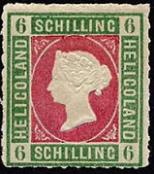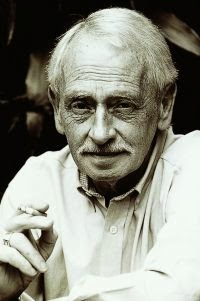
Stamp collecting is the collecting of postage stamps and related objects. It is an area of philately, which is the study of stamps. It has been one of the world's most popular hobbies since the late nineteenth century with the rapid growth of the postal service, as a stream of new stamps was produced by countries that sought to advertise their distinctiveness through their stamps.

The 2¢ Large Queen on laid paper is the rarest postage stamp of Canada. Printed in 1868, it was not discovered until 1925, and so far only three have been found, all used. Many more could exist as at least one sheet must have been printed, and possibly many sheets; however, they may all have been destroyed, or lie unrecognised in stamp collections or on cover.

Giovanni (Jean) de Sperati was an Italian stamp forger. Robson Lowe considered him an artist and even professional stamp authenticators of his time attested to the genuineness of his work. Sperati created what he called a Livre d'Or which he boasted of in his autobiography and which contained 239 favourable opinions as to the genuineness of his forgeries from numerous experts, including Dr. Edward Diena and the Royal Philatelic Society London.

Illegal stamps are postage stamp–like labels issued in the names of existing independent countries or territories used to defraud postal administrations, stamp collectors, and the general public. Often, but not always, a member nation of the Universal Postal Union (UPU) will have asked the UPU to issue an "International Bureau Circular" advising others of the illegal stamps. According to the UPU, the market is estimated to be at least $500 million per year.

The Hawaiian Missionaries are the first postage stamps of the Kingdom of Hawaii, issued in 1851. They came to be known as the "Missionaries" because they were primarily found on the correspondence of missionaries working in the Hawaiian Islands. Only a handful of these stamps have survived to the present day, and so they are amongst the great rarities of philately.

During the period when Heligoland was a British possession, about 20 postage stamps were issued between 1867 and 1890. There were up to eight printings of a single denomination and also a large volume of reprints which are known as the Berlin, Leipzig and Hamburg Reprints, respectively. The Berlin reprints are sometimes better quality than the originals. The reprints were done between 1875 and 1895. Consequently, many "old" collections contain reprints rather than originals. Some believe there were seven million reprints as compared to the known 1½ million originals, of which perhaps half were sold through the post office and the remainder sold to dealers when withdrawn from use. A few printings were never postally sold but nevertheless found their way into the hands of dealers. The stamps were printed by the Prussian State Printing Office in Berlin. They were denominated in the Hamburg Schilling until 1875, when both German Reich and British values appeared on each stamp issue. All are embossed with a silhouette of Queen Victoria excepting the four highest values which represent Heligoland escutcheons.

In general, philatelic fakes and forgeries are labels that look like postage stamps but have been produced to deceive or defraud. Learning to identify these can be a challenging branch of philately.
Russian stamps have been extensively forged. Both rare and common stamps have been forged and certain stamps, for instance those of the Army of the North, are more common forged than genuine.

The Rare 2d Coil was an experimental vertical coil stamp, denominated 2d, issued by the Irish Post Office in 1935 and is one of the scarcest, and most valuable, Irish stamps. It is often referred to by stamp collectors simply as "Scott 68b" or "SG 74b", being the Scott and Stanley Gibbons stamp catalogue numbers respectively.
Herbert J. Bloch, who emigrated from Europe to New York City in 1936, was a philatelist and stamp dealer who became recognized as a leading expert on authentication of rare European postage stamps.
Varro Eugene Tyler, of Auburn, Nebraska, was an American professor of pharmacognosy and philatelist who specialized in the study of forged postage stamps and the forgers who created them.
George Benedict Sloane, of New York City, was a noted philatelic dealer and auctioneer. He was also a popular writer of philatelic articles.
The American Stamp Dealers Association (ASDA) is an international philatelic organization of stamp dealers.
The Confederate Stamp Alliance is a philatelic organization dedicated to the collection and study of postage stamps and postal history of the Confederate States of America (CSA). It is an affiliate of the American Philatelic Society.

Philatelic expertisation is the process whereby an authority is asked to give an opinion whether a philatelic item is genuine and whether it has been repaired or altered in any way.

Edward Loines Pemberton was a pioneering philatelist and stamp dealer who was a leading advocate of the scientific school of philately and a founding member of The Philatelic Society, London, now The Royal Philatelic Society London. Pemberton was entered on the Roll of Distinguished Philatelists in 1921 as one of the fathers of philately. He was born in New York City but educated in Britain by relatives when his parents died shortly after his birth. His son, Percival Loines Pemberton (1875-1949) was also an eminent philatelist.
Forgery is used by some governments and non-state actors as a tool of covert operation, disinformation and black propaganda. Letters, currency, speeches, documents, and literature are all falsified as a means to subvert a government's political, military or economic assets. Forgeries are designed to attribute a false intention and aspirations on the intended target. They force the targeted government to spend a large amount of resources to refute the forgery. Forgeries are an effective tool because of their ability to hold influence even after being proven false.

Dieter Bortfeldt FRPSL was a graphic designer and award-winning philatelist who was a specialist in the philately of Colombia. He designed the "Famous Colombians" and "Tourism" postage stamps of Colombia issued in 1993.

Ramón Antonio Plácido de Torres, known as Plácido Ramón de Torres, was a Spanish stamp illustrator, dealer, and forger.
John Barefoot is a British philatelist, stamp dealer, and publisher, best known for his catalogues of revenue stamps which are known collectively as the "Barefoot catalogue".











